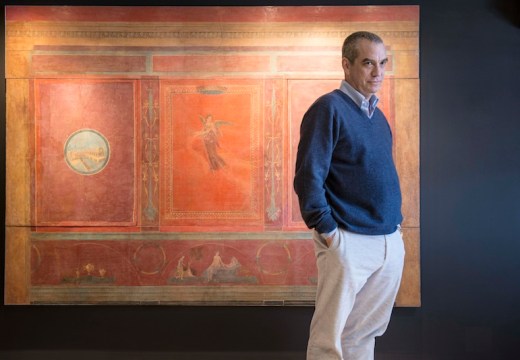Though he never claimed to be an artist, the current wave of exhibitions celebrating the art of John Ruskin suggests that one of the 19th century’s most influential thinkers really did have a second career. ‘John Ruskin: Artist and Observer’ opens this month at the Scottish National Portrait Gallery in Edinburgh (4 July–28 September), following its launch at the National Gallery of Canada in Ottawa. ‘John Ruskin: Photographer and Draughtsman’ has just closed at the Watts Gallery in Compton, Surrey, while the Ruskin Library at Lancaster University continues its regular series of shows with a delightful display of drawings from just one continental tour, ‘“This Mountain Paradise”: Ruskin on the Continent, 1835’ (until 19 September).
The very title of the Edinburgh show asserts Ruskin’s status as an artist. Curated by Christopher Newall and Conal Shields, this show of over 130 works draws not only on the principal Ruskin holdings at Oxford, Lancaster and elsewhere in Britain, but also North America, and most especially on the rich private collection of David Thomson, chairman of Thomson Reuters, whose grandfather once owned The Times and Sunday Times.
The handsome, full-colour catalogue emphasises the aesthetic approach of the show, with drawings arranged by subject matter, rather than chronology. Ruskin’s style underwent considerable development, from the picturesque conventions in which he was educated, to the perceptual precision of his Pre-Raphaelite years, to the looser gestures of his periods of mental instability. Arguably, these changes should be acknowledged chronologically if we are to understand their relation to his writings, but there is no doubt that the selection demonstrates the magnificent skills of Ruskin’s hand and eye.
Yet he exhibited few works in his lifetime, and treated his drawing essentially as a form of research. He drew continuously – a hundred drawings on his 1835 journey alone – but once he had captured what he wanted, he was content to leave off. Few works have the ‘finish’ that would have been expected of a professional artist – which the independently wealthy Ruskin certainly was not. The concentration of the smaller-scale Watts Gallery show, curated by the director of the Ruskin Library, Stephen Wildman, on the links between Ruskin and photography (also explored in an excellent Edinburgh catalogue essay by Ian Jeffrey) demonstrates his delight in the daguerreotype as a tool for capturing what he saw.
Ruskin’s daguerreotypes, bought or taken under his direction by his servants, are a study in their own right. Quaritch are about to publish a catalogue raisonné of the 325 known examples, Carrying Off the Palaces: John Ruskin’s Lost Daguerreotypes, by the specialists Ken and Jenny Jacobson. In 2006 the Jacobsons discovered a cache of material at a country sale that has doubled the size of the collection – choice examples from this fresh trove will be on display in Edinburgh.
But then Ruskin keeps on popping up everywhere. A Venetian study drawing that I had never seen before is in the current Kenneth Clark exhibition at Tate Britain, along with two works he acquired from Ruskin’s art collection – a fragment of what Ruskin thought was a Giorgione fresco, and an unfinished Reynolds. Ruskin’s influence on Clark’s notion of civilisation is worthy of further exploration. His views on the ethics of capitalism were the subject of earnest debate at a session at the International Festival for Business in Liverpool in June. The plant scientist and former keeper of the Royal Botanic Garden in Edinburgh, David Ingram, celebrates Ruskin’s practical environmentalism in a new book, The Gardens of Brantwood, which serves as guide, history and scientific study. The Guild of St George, founded by Ruskin, manages land in the Wyre Forest according to his principles, as well as maintaining his instructive museum collection in Sheffield and promoting his ideas.
All this suggests that Ruskin is important in a wider context than simply that of artist – revelatory though his drawings are – and that his reputation extends beyond art-historical circles. A hundred years ago he fell far out of favour, but since the 1960s his ideas and values have seen a remarkable revival, so that the centenary of his death was celebrated in 2000 in some style. A lot of that was due to an informal grouping, Ruskin To-Day, which acted as a clearing-house for projects honouring the many different facets of his work. In 2019 it will be the bicentenary of his birth, and Ruskin To-Day is already at work. It remains to be seen if Ruskin’s appearance in two forthcoming films, Mike Leigh’s Mr Turner, and the Emma Thompson-scripted Effie Gray, will add further lustre to his name.
Robert Hewison is a critic and cultural historian, whose books on Ruskin include Ruskin on Venice: The Paradise of Cities.
Click here to buy the July/August issue of Apollo
Unlimited access from just $16 every 3 months
Subscribe to get unlimited and exclusive access to the top art stories, interviews and exhibition reviews.















![Masterpiece [Re]discovery 2022. Photo: Ben Fisher Photography, courtesy of Masterpiece London](http://www.apollo-magazine.com/wp-content/uploads/2022/07/MPL2022_4263.jpg)
It’s time for the government of London to return to its rightful home